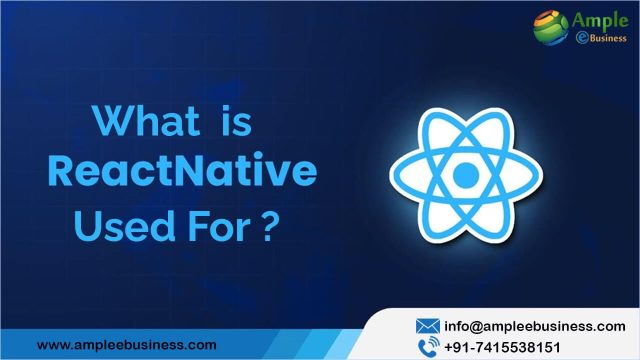
React Native is an open-source JavaScript framework that allows developers to create apps for many platforms, including iOS, Android, and web applications, all from a single code base. It is built on the React framework, and it delivers all of React’s brilliance to mobile application development.
Facebook was responsible for the creation of both frameworks: ReactJS (web) and React Native (mobile). React Native was a Hackathon project that aimed to alleviate the company’s most significant pain point – the need to maintain two code bases for their application. What is the issue with keeping two code bases for such a large application? Duplication of effort and, at times, the solution of the same problem in two distinct methods are commonplace. The solution to these issues is as simple as it gets with React Native language.
What is the purpose of using React Native language?
Using React Native does not have any meaningful industry-specific restrictions on when it can or cannot be used. Most importantly, it serves as a sufficient framework for all customer-facing applications that do not rely heavily on OS-specific features and integrations, such as augmented reality and virtual reality (AR and VR), and do not require complex design or animations in order to gain a competitive advantage.
React Native makes them more efficient to develop, and as of now, it provides sufficient support and modules to allow for the development of a robust application. The fact that your online application was created in React also makes it easy to create a React Native mobile application.
A large number of major companies are actively incorporating React Native into their products, or have just made the decision to do so.
Facebook: React Native used social media platforms with a modern twist
The list of firms that have adopted React Native would be incomplete if Facebook, the project’s original originator, were not included. A major objective of theirs was to bring all of the benefits of web development (rapid iterations, one team to produce the product) to mobile development.
The Facebook team highlighted on their blog how they began by converting only one part of their Facebook for iOS app to React Native (the Events tab), and how they were able to reduce the startup time by half. Given that these enhancements were made at the framework level, the app would automatically benefit from them if it were to be updated to the most recent version of the React Native framework.
Aside from Facebook’s iOS and Android applications, which were converted to React Native, the company also created its Ads Manager from the ground up utilizing React Native technology.
Facebook applications for iOS and Android are not the only ones that rely on React Native, as Instagram and other social media platforms are also using the technology. Instagram began experimenting with React Native in 2016, and in a blog post, the company stated that it helped its product teams to launch features quicker on both iOS and Android devices, as well as on the web. It was also disclosed the proportion of code that was shared between the applications, which was aimed at increasing developer productivity.
Walmart: React Native used in eCommerce websites
Walmart is a global retail corporation based in the United States that operates a chain of supermarkets. Their app allows you to do internet shopping, product searches, and price comparisons in-store. Currently, React Native is used to writing 95 percent of the code that is used in their application.
Walmart cites some of the most significant advantages of React Native, including the ability to use the same automated test suite on both iOS and Android, the ability to manage update delivery dates, and the ability to develop for both platforms at the same time.
Shopify is an e-commerce platform that allows you to create your own online store.
Shopify has revealed that React Native is the company’s mobile strategy for the future, noting that it would assist to strengthen and improve the app experience across iOS and Android platforms in the future. They’ve also teamed with Facebook and are funding prominent members of the React Native community, all in an effort to promote the efforts and contribute to the development of a holistic cross-platform mobile experience for users.
Bloomberg: React Native used in content and media companies.
Bloomberg was one of the first companies to hop on board the React Native bandwagon, releasing the initial version of their new app in 2016. The Bloomberg app provides users with access to material that is tailored to their geographic area, as well as selected news that reflects the time of day. This swiftly evolved into a company-wide change, with ambitions to include React Native into more Bloomberg applications in the future.
Tesla: React Native for companion application
Tesla did not provide any information on why they picked React Native as their development framework. For all Tesla automobiles, the app works as an assistant and a traveling companion. The software syncs with both Android and iOS smartphones and allows users to operate and monitor practically all of Tesla’s functions, including the charger, locks, lights, the panoramic roof, and the horn, from anywhere in the world.
The best projects that use React Native
As previously said, there are no true industry-specific challenges to implementing React Native; instead, it all boils down to defining the core features and competitive advantage of your app before proceeding.
As a result, React Native is an excellent choice for all consumer-facing applications since it provides excellent performance and is (in most circumstances) easier and less expensive to develop than two distinct native apps for the same service or product. The majority of consumer-facing applications do not rely on elaborate animations and user interfaces, which, once again, makes React Native an excellent and trustworthy option for the task at hand.
Why choose React Native Language?
There are multiple advantages to using React Native for the majority of businesses out there. It involves fewer UI concessions as compared to other cross-platform solutions, in addition to being faster and more affordable in terms of delivery and maintenance costs. User and company satisfaction appear to be high, as evidenced by the large number of case studies from enterprises (large and small) that indicate that it appears to meet all of their needs.
Your app’s scalability plans (dealing with a large amount of data may significantly impair the performance of your React Native app), the complexity of the user interface design, and the number of modules that have not yet been developed in React Native are the most significant React Native challenges to consider (they can take up a lot more time from your development team). Consult with Ample eBusiness to determine whether or not there are any in your app’s backlog.
Having said that, keep in mind that the success of your app is highly dependent on the talents and knowledge of the developers. Whenever you are developing a cross-platform app, find a partner that will be able to evaluate all of the dangers and possibilities that your app may face in the particular technological environment.
When working with React Native, it is beneficial if your partner has some previous expertise in developing native applications. We, at Ample eBusiness, incorporate React Native in our web applications. To make the best out of React Native for your website, visit Ample eBusiness.


